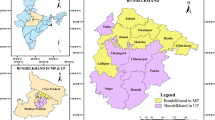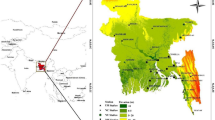Abstract
The current study evaluates the impact of drought on Pakistan's agriculture sector at national and provincial scales during 2000–2020 using the Standardized Precipitation Evapotranspiration Index (SPEI-3). Severe drought events were observed during 2001, 2003, 2006, 2007, 2008, 2012, 2017, and 2018, which are used to demonstrate the impact of drought on agriculture. Balochistan and Sindh provinces are severely affected by drought due to their arid/hyper-arid climate nature. Drought severity is relatively high in Kharif season (ranging from severe to moderate) compared with drought in Rabi season. The average SPEI-3 during Kharif (Rabi) season across KP, Punjab, Balochistan, and Sindh provinces are − 0.48 to − 1.02 (0.47 to − 0.83), − 1.33 to − 1.68 (− 0.93 to − 1.36), − 1.21 to − 1.54 (− 0.76 to − 1.30), and − 1.73 to − 2.07 (1.54 to − 1.96), respectively. The results showed that Punjab, Balochistan, and Sindh provinces are most vulnerable to drought. As the drought index becomes more positive, the maize yield increases at both national and provincial levels. Drought has mixed effects on the rice yield. Similarly, the decline in drought severity leads to an increase in sugarcane, tobacco and wheat yields. The decrease in drought severity has a positive impact on the irrigated area under canals, wells and tubewells at both national and provincial levels. Similarly, an increase in the drought index also leads to an increase in the total cultivated and cropped area.






Similar content being viewed by others
References
Adnan S, Ullah K (2020) Development of drought hazard index for vulnerability assessment in Pakistan. Nat Hazards 103(3):2989–3010
Adnan S, Ullah K, Gao S, Khosa AH, Wang Z (2017) Shifting of agro-climatic zones, their drought vulnerability, and precipitation and temperature trends in Pakistan. Int J Climatol 37:529–543
Adnan S, Ullah K, Shuanglin L, Gao S, Khan AH, Mahmood R (2018) Comparison of various drought indices to monitor drought status in Pakistan. Clim Dyn 51(5–6):1885–1899
Ahmad S, Hussain Z, Qureshi AS, Majeed R, Saleem M (2004) Drought mitigation in Pakistan: current status and options for future strategies, 85. IWMI
Ahmed K, Shahid S, Bin Harun S, Wang X-J (2016) Characterization of seasonal droughts in Balochistan Province, Pakistan. Stoch Environ Res Risk Assess 30(2):747–762
Ali S, Liu Y, Ishaq M, Shah T, Ilyas A, Din IU (2017) Climate change and its impact on the yield of major food crops: Evidence from Pakistan. Foods 6(6):39
Ashraf M, Routray JK (2015) Spatio-temporal characteristics of precipitation and drought in Balochistan Province. Pak Nat Hazards 77(1):229–254
Badar H, Ghafoor A, Adil SA (2007) Factors affecting agricultural production of Punjab (Pakistan). Pak J Agric Sci 44(3):506–510
Blunden J, Arndt DS, Baringer MO (2011) State of the climate in 2010. Bull Am Meteorol Soc 92(6):S1–S236
Ciheam-Iamz ZS (2010) Economics of drought and drought preparedness in a climate change context. In: Second international conference on drought management economics of drought and drought preparedness in a climate change context. CIHEAM-IAMZ; FAO; Ministry of Agriculture and Rural Affairs of Turkey
Colaizzi PD, Gowda PH, Marek T, Porter DO (2009) Irrigation in the Texas high plains: a brief history and potential reductions in demand. Irrig Drain J Int Comm Irrig Drain 58(3):257–274
Dai A (2013) Increasing drought under global warming in observations and models. Nat Clim Change 3(1):52–58
Dilawar A, Chen B, Arshad A, Guo L, Ehsan MI, Hussain Y, Kayiranga A, Measho S, Zhang H, Wang F, Sun X (2021) Towards understanding variability in droughts in response to extreme climate conditions over the different agro-ecological zones of Pakistan. Sustainability 13(12):6910
Dilley M, Chen RS, Deichmann U, Lerner-Lam AL, Arnold M (2005) Natural disaster hotspots: a global risk analysis. The World Bank
Eklund L, Seaquist J (2015) Meteorological, agricultural and socioeconomic drought in the Duhok Governorate. Iraqi Kurdistan Nat Hazards 76(1):421–441
Gurian-Sherman D (2012) High and dry: why genetic engineering is not solving agriculture's drought problem in a thirsty world. Union of Concerned Scientists
Hanif M, Khan AH, Adnan S (2013) Latitudinal precipitation characteristics and trends in Pakistan. J Hydrol 492:266–272
Hannaford J, Lloyd-Hughes B, Keef C, Parry S, Prudhomme C (2011) Examining the large-scale spatial coherence of European drought using regional indicators of precipitation and streamflow deficit. Hydrol Process 25(7):1146–1162
Haroon MA, Zhang J, Yao F (2016) Drought monitoring and performance evaluation of MODIS-based drought severity index (DSI) over Pakistan. Nat Hazards 84(2):1349–1366
Hayes MJ, Svoboda MD, Wardlow BD, Anderson MC, Kogan F (2012) Drought monitoring: historical and current perspectives. In: Wardlow BD, Anderson MC, Verdin JP (eds) Remote sensing of drought: innovative monitoring approaches. CRC Press/Taylor & Francis
Hussain A, Bangash R (2017) Impact of climate change on crops’ productivity across selected agro-ecological zones in Pakistan. Pak Dev Rev 56(2):163–187
IPCC (2019) Climate Change and Land: an IPCC special report on climate change, desertification, land degradation, sustainable land management, food security, and greenhouse gas fluxes in terrestrial ecosystems
Jamro S, Channa FN, Dars GH, Ansari K, Krakauer NY (2020) Exploring the evolution of drought characteristics in Balochistan. Pak App Sci 10(3):913
Kang Y, Khan S, Ma X (2009) Climate change impacts on crop yield, crop water productivity and food security: a review. Prog Nat Sci 19(12):1665–1674
Kazmi DH, Li J, Rasul G, Tong J, Ali G, Cheema SB, Liu L, Gemmer M, Fischer T (2015) Statistical downscaling and future scenario generation of temperatures for Pakistan Region. Theoret Appl Climatol 120(1–2):341–350
Khan AN (2013) Analysis of 2010-flood causes, nature and magnitude in the Khyber Pakhtunkhwa. Pak Nat Hazards 66(2):887–904
Khan N, Shahid S, Bin Ismail T, Wang X-J (2019) Spatial distribution of unidirectional trends in temperature and temperature extremes in Pakistan. Theor App Climatol 136(3–4):899–913
Khan N, Sachindra DA, Shahid S, Ahmed K, Shiru MS, Nawaz N (2020) Prediction of droughts over Pakistan using machine learning algorithms. Adv Water Resour 139:103562
Kogan F, Adamenko T, Guo W (2013) Global and regional drought dynamics in the climate warming era. Remote Sens Lett 4(4):364–372
Kumar KK, Rajagopalan B, Cane MA (1999) On the weakening relationship between the Indian monsoon and ENSO. Science 284(5423):2156–2159
Kurukulasuriya P, Mendelsohn R, Hassan R, Benhin J, Deressa T, Diop M, Eid HM, Fosu KY, Gbetibouo G, Jain S, Mahamadou A (2006) Will African agriculture survive climate change? World Bank Econ Rev 20(3):367–388
Li Y, Ye W, Wang M, Yan X (2009) Climate change and drought: a risk assessment of crop-yield impacts. Clim Res 39(1):31–46
McKee TB, Doesken NJ, Kleist J, (1993) The relationship of drought frequency and duration to time scales. In: Proceedings of the 8th conference on applied climatology. Boston, pp. 179–183
Mendelsohn R (2014) The impact of climate change on agriculture in Asia. J Integr Agri 13(4):660–665
Miyan MA (2015) Droughts in Asian least developed countries: vulnerability and sustainability. Weath Clim Extr 7:8–23
Paull SH, Horton DE, Ashfaq M, Rastogi D, Kramer LD, Diffenbaugh NS, Kilpatrick AM (2017) Drought and immunity determine the intensity of West Nile virus epidemics and climate change impacts. Proc R Soc b Biol Sci 284(1848):20162078
Paulo AA, Rosa RD, Pereira LS (2012) Climate trends and behaviour of drought indices based on precipitation and evapotranspiration in Portugal. Nat Haz Earth Syst Sci 12(5):1481–1491
PBS (2011) Pakistan Bureau of Statistics: agricultural statistics of Pakistan. Government of Pakistan, statistics division, Pakistan bureau of statistics, available at: http://www.pbs.gov.pk/content/agricultural-statistics-pakistan-2010-11. Last access: 1 August 2020
Rahman KU, Shang S, Shahid M, Li J (2018) Develo** an ensemble precipitation algorithm from satellite products and its topographical and seasonal evaluations over Pakistan. Remote Sens 10(11):1835
Rahman KU, Shang S, Shahid M, Wen Y (2019) Performance assessment of SM2RAIN-CCI and SM2RAIN-ASCAT precipitation products over Pakistan. Remote Sens 11(17):2040
Rahman KU, Shang S, Shahid M, Wen Y (2020a) An appraisal of dynamic Bayesian model averaging-based merged multi-satellite precipitation datasets over complex topography and the diverse climate of Pakistan. Remote Sens 12(1):10
Rahman KU, Shang S, Shahid M, Wen Y (2020b) Hydrological evaluation of merged satellite precipitation datasets for streamflow simulation using SWAT: a case study of Potohar Plateau. Pak J Hydrol 587:125040
Rahman KU, Shang S, Shahid M, Wen Y, Khan AJ (2020c) Development of a novel weighted average least squares-based ensemble multi-satellite precipitation dataset and its comprehensive evaluation over Pakistan. Atmos Res 246:105133
Rahman KU, Shang S, Shahid M, Wen Y, Khan Z (2020d) Application of a dynamic clustered bayesian model averaging (DCBA) algorithm for merging multisatellite precipitation products over Pakistan. J Hydrometeorol 21(1):17–37
Rahman KU, Shang S, Zohaib M (2021) Assessment of merged satellite precipitation datasets in monitoring meteorological drought over Pakistan. Remote Sens 13(9):1662
Shahid M, Rahman KU (2021) Identifying the annual and seasonal trends of hydrological and climatic variables in the indus Basin Pakistan. Asia-Pacific J Atmos Sci 57:191–205
Troy TJ, Kipgen C, Pal I (2015) The impact of climate extremes and irrigation on US crop yields. Environ Res Lett 10(5):054013
Tubiello FN, Soussana JF, Howden SM (2007) Crop and pasture response to climate change. Proc Natl Acad Sci 104(50):19686–19690
Vicente-Serrano SM, Beguería S, López-Moreno JI (2010) A multiscalar drought index sensitive to global warming: the standardized precipitation evapotranspiration index. J Clim 23(7):1696–1718
Walthall CL, Anderson CJ, Baumgard LH, Takle E, Wright-Morton L (2013) Climate change and agriculture in the United States: effects and adaptation. USDA Technical Bulletin 1935. Washington
Willmott CJ, Matsuura K (1995) Smart interpolation of annually averaged air temperature in the United States. J App Meteorol Climatol 34(12):2577–2586
**e H, Ringler C, Zhu T, Waqas A (2013) Droughts in Pakistan: a spatiotemporal variability analysis using the Standardized Precipitation Index. Water Int 38(5):620–631
Yu M, Li Q, Hayes MJ, Svoboda MD, Heim RR (2014) Are droughts becoming more frequent or severe in China based on the standardized precipitation evapotranspiration index: 1951–2010? Int J Climatol 34(3):545–558
Acknowledgements
The authors are thankful to Pakistan Meteorology Department (PMD) and Water and Power Development Authority (WAPDA) for providing the in-situ precipitation and temperature data.
Funding
This research was partially supported by the National Natural Science Foundation of China (Grant number 51839006) and the Shuimu Scholar Program of Tsinghua University (Grant number 2020SM072).
Author information
Authors and Affiliations
Corresponding author
Ethics declarations
Conflict of interest
Authors declare no conflict of interest.
Additional information
Publisher's Note
Springer Nature remains neutral with regard to jurisdictional claims in published maps and institutional affiliations.
Rights and permissions
Springer Nature or its licensor holds exclusive rights to this article under a publishing agreement with the author(s) or other rightsholder(s); author self-archiving of the accepted manuscript version of this article is solely governed by the terms of such publishing agreement and applicable law.
About this article
Cite this article
Hussain, A., Jadoon, K.Z., Rahman, K.U. et al. Analyzing the impact of drought on agriculture: evidence from Pakistan using standardized precipitation evapotranspiration index. Nat Hazards 115, 389–408 (2023). https://doi.org/10.1007/s11069-022-05559-6
Received:
Accepted:
Published:
Issue Date:
DOI: https://doi.org/10.1007/s11069-022-05559-6




